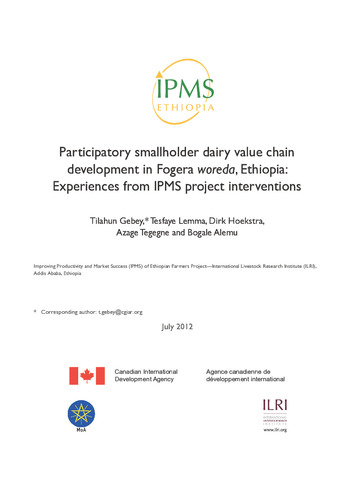Participatory smallholder dairy value chain development in Fogera woreda, Ethiopia: Experiences from IPMS project interventions
Abstract
Market-oriented smallholder dairy in Fogera has an opportunity for growth because of growing urban population in the district itself as well as in the wider Bahr Dar–Gondar milkshed. IPMS in 2005 introduced a participatory market-oriented dairy value chain development approach with partner organizations. IPMS together with its partners also identified gaps in the dairy value chain through Participatory Rapid Appraisal (PRA) and also designed interventions involving key value chain actors. This approach included increased use of knowledge capturing and sharing by the extension services. Major production interventions were the development of communal grazing areas through clearance of noxious weed called Hygrophilla auriculata and introduction of area enclosure, backyard fodder development and increased use of rice crop residues. Input service supply interventions included community-based trypanosomosis control and bulls stations. IPMS and its partners also provided the required support for establishment of two milk processing marketing cooperatives. Communal grazing area development is now practised in 16 villages (PAs) and harvested biomass production was estimated at 7 to 11 t of DM/year. As a result of the cut-and-carry system, the proportion of legumes increased, thus improving its nutritive value. The increased availability of the rice straw and bran resulting from rice value chain development in Fogera has also impacted dairy production. Urea treatments of rice straw as well as supplementary feeding with rice bran were demonstrated in 13 PAs. An on-farm experiment conducted by an MSc student indicated doubling of daily milk yields. However, use of straw could be increased further if urea for the treatment of straw could be made available in the dry season. Trypanosomosis control introduced in infested areas has significantly reduced the number of infected animals and the program is now institutionalized by regional, district and NGO partners. The introduction of bull stations resulted in increased number of improved Fogera breed cows and crossbreed with Holstein-Frisians. However, the number of improved dairy cows is still low and the District should consider the recently introduced mass insemination approach with the help of hormones. Marketing and processing of milk in urban and peri-urban areas through formation of small cooperatives has started; however, impact is still limited due to lack of business orientation, and alternative marketing outlets for individual producers. While some linkages were made with the larger Bahr Dar milkshed, more attention needs to be paid to this market once milk production increases. A household survey conducted in 2009, which assessed the combined impact of all interventions, showed significant differences in milk quantities sold by adopter and non-adopter households in the urban areas and doubling of butter production/sales in the rural areas. It is noted that this additional butter sales benefits rural women since they manage the production and sale of butter.

